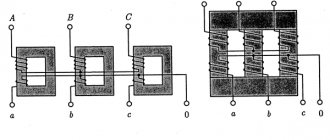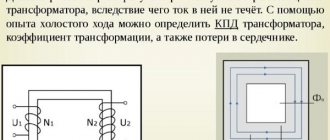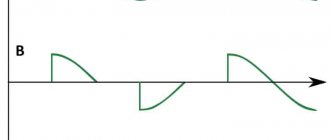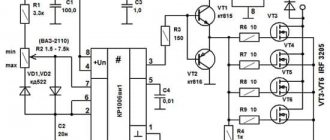After purchasing a home on the secondary real estate market, first of all, new owners, as a rule, change the wiring. In the process, it turns out that replacing the input circuit breaker is not so simple. If to install a model of the same type it is enough to call the electricians of the company providing the services, then to connect an AV with a large rated current, you need to submit an application so that the allocated electrical power is increased. Detailed information on this issue is provided below.
What are the dangers of exceeding the permitted power?
Currently, when it detects that the maximum load has been exceeded, the electric company introduces a consumption limitation mode. The basis for this is a violation of the obligations specified in the energy supply agreement. As a rule, limiting consumption is turning off the electric current. The algorithm for sending such a notification is shown in the figure.
Example of a consumer notice
After 10 days after sending the notice, the company disconnects the power supply. To avoid this, the consumer must eliminate the violation within ten days, and then contact the service provider to draw up the appropriate report. Electricity supply will be restored after the electric company pays the penalty in accordance with the contract.
More serious consequences may arise if, in addition to violating the amount of allocated energy, an accusation of uncontrolled electricity consumption is brought forward. The basis for this will be the removal of seals from the input machine. You can get more detailed information about the consequences of uncontrolled electricity consumption, electricity metering rules, etc. on our website.
Seal on the introductory machine (marked in red)
Install sectional circuit breakers that provide current selectivity protection
In order not to lead to the disconnection of the entire facility from the power supply due to an overload of a particular section, for example, a section of sockets when several sufficiently powerful electrical receivers are turned on at the same time, sectional circuit breakers
.
They are installed after the PZR
and protect the section circuits from short circuit currents and overloads.
Each sectional circuit breaker protects one specific section. The current settings of the thermal relays built into them are selected in such a way that if any section is overloaded, the sectional machine protecting it will turn off earlier, without leading to the operation of the PZR.
Protection by sectional circuit breakers
effective, but not very convenient.
Firstly, the load in several sections may not reach the maximum value at which the sectional machine would operate, but in total it may be large enough for the PZR to operate.
Secondly, to restore the protective functions of a triggered machine, you need to manually transfer it from non-working to working state - the lever from position “0” (or “off”) to position “1” (or “on”).
Design power for industrial facilities
The design capacity of an industrial enterprise depends on:
- type of product;
- technologies used;
- expected maximum load during the year;
- type of products;
- type of equipment and the degree of its adaptation to technology.
There are many calculation methods, all of them must have common properties:
- ease of calculation;
- versatility in determining loads for different levels of energy consumption and distribution;
- accuracy of results;
- ease of determining the indicators on which the method is based.
The main indicators are calculated using the same formulas, but with different correction factors.
For three-phase electric motors, the installed power is:
Р = Рн/(η x cos φ), where:
- Рн – nominal power indicator from the data sheet;
- η – efficiency of the electric motor;
- cos φ – power coefficient.
An increase in the allocated power, according to technical conditions, must be agreed upon with the energy supply organization. For this purpose, recalculations are carried out for input cables and protection devices based on the new installed power. But the decision to allocate depends on the availability of free capacity.
DESIGN AND PRINCIPLE OF OPERATION OF EPU
Uninterrupted power supply of stationary communication equipment requires direct current electrical energy with rated voltages of 24, 48 and 60 V. This energy is provided by power supply units produced by various domestic and foreign companies. One of them is the German company Voigt&Haeffner (V&H), which produces units for various capacities.
The work presents a medium-power electronic control unit of the SVS-G48/75-8GRS type with a rated voltage of 48 V and a rated current of 75 A. It is developed on the basis of a modular architecture that allows you to increase the power and develop the operational capabilities of the installation. The equipment is located in two cabinets. In the top are the main elements of the installation, in the bottom are the batteries. The placement of installation elements is shown in Fig. 1.
Main EPU devices and their designations:
| Rectifier modules | GR 1-6 |
| Accumulator battery | B |
| Monitoring and control module | S.M. -7 |
| Battery deep discharge protection devices | K 27 M |
| Load and battery current monitoring devices | R 18 N , R 19 N |
| Thermal sensor to ensure the temperature dependence of the battery charging current | P.T. -100 |
| Terminals for connecting 400/220 V AC mains | X 9 |
| Automatic circuit breakers at the input of rectifier modules | Q 211– Q 216 |
| Automatic circuit breakers at the output of rectifier modules | Q 231– Q 236 |
| Automatic machines in load circuits (have signal contacts for closing when the load is disconnected) | Q 50– Q 54 |
| Battery fuses - circuit breakers | F 21– F 22 |
| In laboratory installations, instead of 6 rectifier modules, only 2 are installed, and the battery consists of 1 group. This must be taken into account during testing. A 48/24V converter is additionally installed in the free space in the SVS. |
Rice. 1. Placement of elements
The block diagram of the installation is shown in Fig.
What it is
During capital construction during the USSR, for example in Khrushchev buildings, i.e. In most of the residential premises that are still in use today, even at the design stage, the allocated power was 1.5 kW per apartment. Later, the established electricity rate increased to 3 kW, as it became necessary to increase it due to the increased “gluttony” of consumers. Practice shows that 10-16 Ampere plugs were usually installed in electrical panels and meters, so that the maximum current consumed by an apartment was limited to a total electrical power of 3 kW for apartments with a gas stove. For apartments where an electric stove is installed, 7 kW is allocated. In new buildings, the allocated power can reach up to 15 kW. This scatter is due to the fact that during the construction of old houses (60s, 70s) there simply were not such powerful consumers and as many household appliances as there are now.
The allocated power is the maximum amount of electricity consumed at one point in time.
In addition, in order to enter the established limit, sometimes you need to enter not just 1 phase, as often happens, but as many as 3 phases. This is necessary for connecting modern household appliances, such as powerful electric boilers and electric stoves. This is especially true in commercial premises and industries of any scale, where a lot of electricity is needed (up to 30 kW and above).
Example
. To heat a country house that is not equipped with gas equipment, solid fuel and electric boilers are installed, the latter are safer and more convenient. For heating a house with an area of 100 sq.m. you need a boiler with a power of about 7-10 kW, an electric stove consumes another 3-5 kW. In total, it is necessary to increase the established electricity limit to a minimum of 15 kW and supply electricity in three phases.
To find out the allocated power for a private house or apartment, you need to contact the operating organization (in Moscow and the region - this is Mosenergosbyt OJSC). The help contains information about the allocated and average power consumption. It will be needed if you are preparing documents for an increase; this will be discussed in detail below.
for Individuals:
1. Layout of power receiving devices (ERDs) that need to be connected to the electrical networks of the network organization. The plan contains information about the geographical location of the site on which the EPU are (will be) located. 2. List and power of energy receiving devices. 3. Documents confirming the ownership or other basis provided by law for a capital construction project and (or) the land plot on which (in which) the applicant’s objects are located (will be located), or the right of ownership or other basis provided by law for energy receiving devices (provided in one copy in the form of a simple copy. In the case of shared participation in the rights to an object, land plot or power receiving devices, written consent of the remaining owners or their authorized person is provided for the execution of documents on technological connection in the name of the applicant and the implementation of the necessary technical measures in relation to the common property. 4. If an application is submitted through a representative, a power of attorney or other documents confirming the authority of the applicant’s representative (submitting or receiving documents).
Estimated power of residential buildings
The installed power in a residential building is determined based on the sum of the consumer rated powers of all electrical appliances and installations, and the calculated power - taking into account the expected simultaneous switching factor.
Each subscriber has a delineation act, which records the installed and calculated power. These values are different for houses and apartments. Houses and some apartments are usually supplied with three phases, which allows increasing the consumption (calculated) indicator. Single-phase input significantly limits consumption. The load is controlled by protective equipment designed to handle the maximum possible currents.
- If there is no power plant in the house or apartment, the calculated energy is determined by the formula:
P1 = Pmax + M x Rchel, where:
- Pmax is the power of the largest receiver installed in the apartment,
- M – number of inhabitants,
- Rchel – estimated power per person (for example, 1 kW);
Important! This formula does not take into account heating of residential premises
- The estimated power of the power supply cable for an apartment building is made taking into account the number of apartments:
Р = Р1 x nxk + Ra + Рл, where:
- n – number of apartments,
- k – simultaneity coefficient (it ranges from 0.6 to 0.8),
- Ra – installed power of administrative electrical receivers,
- RL – elevators.
If there is no data, then Pa is taken equal to 0.5 kW, Rl = 20 kW.
- With electric heating, Po = P + K1 x ΣRkv, where:
- P – design power without electric heating,
- K1 – coefficient of simultaneity of heat load in n apartments,
- Rkv – heating energy in one apartment, kW.
Important! Accurate determination of the estimated power required for space heating requires detailed calculations, which are carried out jointly with builders and building designers. In residential buildings with predominant heating elements cos φ = 1
- The calculated power indicator for a group of buildings is determined by the empirical formula:
Рз = 0.95 x kx ΣР, where Р is energy for one building.
Cosine phi for various consumers - table
| Name of electrical appliance | cos φ |
| Boiler | 1 |
| Bulgarian | 0.8 |
| Vacuum pump | 0.85 |
| Induction furnaces | 0.85 |
| Compressor | 0.7 |
| Computer | 0.95 |
| Coffee maker | 1 |
| Gas discharge lamps | 0.4-0.6 |
| Fluorescent lamps | 0.95 |
| Incandescent lamps | 1 |
| Heater | 1 |
| Hammer | 0.85 |
| Vacuum cleaner | 0.9 |
| Microwave | 1 |
| Washing machine | 0.9 |
| TV | 1 |
| Iron | 1 |
| Hairdryer | 1 |
| Fridge | 0.95 |
| Electric drill | 0.85 |
| Electric motors | 0.7-0.8 |
| Electric stove | 1 |
| Electric arc welding | 0.3-0.6 |
| Electric kettle | 1 |
Calculation of required power
This calculation will be needed to understand whether the amount of allocated electrical power for an apartment or house will be sufficient. To do this, you will need to calculate the maximum load by summing up the corresponding parameters of all consumer electrical installations. Moreover, it is necessary to take into account all household electrical appliances that can be turned on at the same time.
As a rule, all the necessary information is indicated on a sticker affixed to the equipment body or is given in the documentation. If the sticker has become unreadable and the technical data sheet has been lost, you can use the table that shows the typical active power of household equipment.
Table of approximate power consumption of various household appliances
Having calculated the total consumption, do not rush to consider the work completed; it is necessary to add a reserve, taking into account a possible increase in load over time. As a rule, the size of the reserve is set at 20-30% of the calculated parameters.
By adding these two values, we get a result that can be compared with the allowed power. If it turns out to be less than the calculated load, it makes sense to think about applying for an additional 1 kW or 3 kW. Details about adding additional kilowatts will be discussed below.
Install the PZR corresponding to the permitted power
If the permitted power
is limited or the home is oversaturated with electrical receivers - household electrical appliances, electronics, lighting devices - and there is a possibility of power consumption exceeding its value, then instead of the input circuit breaker it is necessary to install a
PZR
(protective relay device), consisting of an electronic unit, a current relay, a magnetic starter and circuit breaker.
When the load current of the internal network reaches a threshold value corresponding to the permitted power
, the current relay is triggered and switches the internal network to periodic power supply mode: the network is connected to voltage for 5 seconds, then a pause of 180 seconds follows, during which there is no voltage in the network.
This mode lasts until the subscriber takes measures to reduce current consumption.
PZR
multifunctional. In addition to limiting the load current, it protects the internal network from short circuit currents, insulation leakage currents, and overvoltage.
Calculation of maximum input power
Electrical load is understood as the amount of electric current flowing in the network when an electrical receiver or group of electrical receivers is turned on.
Based on electrical loads, conductors are selected (design, cross-section) at all stages of generation, conversion, transmission and consumer use of electrical energy and its distribution. There are 3 methods for determining the electrical loads of objects:
1 Method for constructing a daily graph of electrical loads;
2 Method of ordered diagrams or method of effective number of electrical receivers;
3 Analytical method
To calculate the load at the entrance to the dairy block building, the method of constructing a daily graph of electrical loads is used. Since it is possible to install a clear time cycle of technological equipment at the facility.
To construct a load graph, auxiliary table No. 7 is compiled.
Table No. 7. - Auxiliary table for constructing a load graph.
| Technological operation | power, kWt | Operation duration | |||||||||||||||||||||
| 1 | 2 | 3 | 4 | 5 | 6 | 7 | 8 | 9 | 10 | 11 | 12 | 13 | 14 | 15 | 16 | 17 | 18 | 19 | 20 | 21 | 22 | 23 | 24 |
| 1 Milk pump | 2,2 | ||||||||||||||||||||||
| 2 Vacuum - pump | 8 | ||||||||||||||||||||||
| 3 Cooler | 18,74 | ||||||||||||||||||||||
| 4 Separator | 2,2 | ||||||||||||||||||||||
| 5 Heater | 12 | ||||||||||||||||||||||
| 6 Lighting | 1,74 |
A daily load schedule is drawn up (Figure 1).
Figure 1 - Graph of electrical loads.
The graph shows that the maximum active power is:
The installed power is determined by summing up all the loads present at the facility:
, (32)
where is the power of the i-th load, kW.
Electricity consumption per day is determined through the geometric area of the graph:
(33)
Average power consumption per day:
(34)
The average value of the power factor of the loads involved in the formation of the maximum load:
(35)
The total power at the input is determined:
(36)
Input current at maximum load:
(37)
Based on the operating current, we determine the cross-section of the input cable based on the conditions.
Iadd? Iр, (38)
Iadd = 65A? Iр = 52.65A.
We accept for installation a cable at the AVBBShv 5*25 input.
Electrical load graphs
- individual - schedules of electrical receivers;
- group - components from individual graphs, taking into account the interdependence of loads according to technology conditions. Group graphs can be used when selecting equipment and conductors that supply groups of electrical receivers (mainly for 2UR);
- consumers in general , powered by 6UR-4UR, for whom taking into account the entire variety of individual graphs of an almost countable (almost infinite) set of electrical receivers makes it impossible to use direct calculation methods (even if all graphs are available at the time of making a technical decision).
For graphs, the averaging interval D is important, the sum of which determines the 30-minute interval taken as the estimated time.
For individual graphs, At must correspond to the physics of the process being studied. For example, for relief welding machines it should be small due to the sharply variable operating mode displayed by the load graph, when the welding pulse time is t = 0.04...0.12 s; pause time between pulses t2 = 0.02…0.20 s; number of consecutive pulses - 2... 10. Registration of ordinates of load graphs of a group of electrical receivers connected to any switching device 2UR, and consumer graphs 6UR-4UR with existing recording devices can be carried out with any averaging interval. When measuring at one electrical connection with an interval of At = 3 minutes, the total number of recorded points per day will be 24 • 60:3 = 480; in total for a year - 175,200. This number of measurements makes it difficult to use the graph over a large time interval and for a large number of connections. In addition to the technical difficulties of collecting information, summing up the results, recording and processing, there are also economic limitations.
If the individual load graphs of electrical receivers are known and the need arises for the analytical formation of group load graphs, then the autocorrelation function of the individual load graph considered as the implementation of a stationary random process is applicable.
To get it, it is enough to take the readings of the electricity meter, convert them into kilowatt-hours and divide by 0.5 hours. The deviation from Pmax is taken into account by the meter, which determines the average load Psr for the interval. The summation carried out by the meter over 30 minutes simplifies assumptions about the value and probability of load changes over D.
From Fig. 2.4 it is obvious that the value of P depends on the origin. It is technically possible to calculate Pmax over a 30-minute interval starting at any moment. The question arises about the purpose of such measurements and their economic feasibility, which is justified when regulating the power consumption of enterprises and creating systems for managing electrical loads. For now, as a rule, measurements are made at a fixed time, coinciding with the beginning of the hour. The maximums averaged by the formula are fixed, forming a daily graph (Fig. 2.7), consisting of 48 points.
On the daily chart, there are morning and evening (usually larger) maximums and a night trough, when the load drops to a minimum. The hours of passage of the morning and evening maximums are set by the energy supply organization.
The largest of the maximums is taken as the daily maximum (when regulated, the maximum may not coincide with these values) and is plotted on the annual (monthly, quarterly) load graph. The highest of the daily maximums during the quarter shall be taken as the stated maximum and paid. In this case, the actual calculated and declared maximums will coincide. The average daily power is determined similarly.
Document overview
The Procedure for forming a consolidated forecast balance of production and supply of electricity (capacity) within the Unified Energy System of Russia by region has been re-approved.
The objectives of creating a balance are to satisfy the demand for electricity and power, minimize the costs of their production and supply, ensure reliable energy supply, as well as balance the total cost of electricity and power supplied to the wholesale market at regulated prices (tariffs) and sold under regulated sales contracts (supplies) in price and non-price zones.
Balance is needed to achieve 3 goals. The first is the calculation of regulated prices (tariffs) for electricity and power, subject to state regulation, as well as regulated prices (tariffs) for services provided in the wholesale and retail markets. The second is the conclusion by participants of the wholesale market of agreements, on the basis of which the purchase and sale of electricity and (or) capacity is carried out on such a market. The third is the conclusion by producers (suppliers) of purchase and sale (supply) agreements for electricity and capacity with a supplier of last resort in regions united in non-price zones. We are talking about manufacturers (suppliers) who are subject to the legal requirement to sell produced electricity (power) only on the wholesale market and who, before receiving the status of a wholesale market entity, participate in purchase and sale relations on the retail market.
The Procedure for determining the ratio of the total annual forecast volume of electricity consumption by the population and equivalent categories of consumers to the volume of electricity corresponding to the annual average value of the forecast capacity determined in relation to these categories of consumers was also approved.
The ratio is established to determine the planned volumes of consumption by the population for the next regulated period based on the results of control measurements. They are carried out by guaranteeing suppliers, energy supply and sales organizations that supply electricity (power) to the population and equivalent categories of consumers in the year preceding the next regulated period.
The order approving the previous procedure for the formation of a consolidated forecast balance was declared invalid.
To view the current text of the document and obtain complete information about the entry into force, changes and procedure for applying the document, use the search in the Internet version of the GARANT system:
Nikolai Montile
expert of the Internet project “Legal aspects of energy supply. Consulting"
In his article, the author analyzes judicial practice on the issue of the possibility of using values (such as permitted power, one-time power, permitted load, one-time load, installed power) contained in documents on technological connection of electric power facilities as maximum power, as well as judicial practice on the issue the procedure for reducing these quantities, measured in volt-amperes, to the maximum power value, measured in watts
Maximum power is important for participants in retail electricity markets. Using the maximum power value, many of the obligations of these participants are determined. For example, the maximum power is taken into account in the following cases:
1) when classifying the consumer as one of the consumers whose maximum power of energy receiving devices within the boundaries of the balance sheet is at least 670 kW or less than 670 kW. For consumers (buyers in the interests of these consumers) with a maximum power of at least 670 kW, special conditions for operating in retail markets are established, including:
A) the obligation to equip energy receiving devices with metering devices that allow measuring hourly volumes of electrical energy consumption with an accuracy class of 0.5S and higher, ensuring the storage of data on hourly volumes of electrical energy consumption for the last 90 days or more, or included in the accounting system (paragraph 2, paragraph. 139, paragraph 143 of the Basic Provisions for the functioning of retail electricity markets, approved by Decree of the Government of the Russian Federation dated May 4, 2012 No. 442 (hereinafter referred to as the Basic Provisions No. 442));
B) the consequences of failure to comply with those specified in paragraph. 2 clause 139, clause 143 of the Basic Provisions No. 442 of the requirements for metering devices in the form of a calculation method for determining the volume of electrical energy consumption during scheduled peak load hours on working days of the billing period (paragraph 3 clause 181 of the Basic Provisions No. 442);
B) special requirements for reactive power metering devices (paragraph 3, clause 139 of Basic Provisions No. 442);
D) the inability to choose and apply the first and second price categories from July 1, 2013 (paragraph 9, paragraph 97 of the Basic Provisions No. 442);
E) application from 07/01/2013 of the third price category in the absence of notification of the choice of a price category other than the first and second (paragraph 15, clause 97 of the Basic Provisions No. 442);
E) application of increasing (decreasing) coefficients in case of deviation of the actual volumes of electrical energy consumption from the contractual ones for consumers (buyers) in the territories of non-price zones, calculated before 07/01/2013 at single-rate prices (tariffs) for electrical energy (power) (para. 4, 6 p. 109 of the Basic Provisions No. 442);
G) the obligation of these consumers (buyers) in the territories of non-price zones to carry out hourly planning of electricity consumption (paragraph 1, clause 110 of the Basic Provisions No. 442);
H) inclusion in the invoice for payment of electric energy (power) issued to such consumers (buyers) as a separate line of the value of the reserved maximum power (clause 80 of the Basic Provisions No. 442, clause 8(1) of the Rules for non-discriminatory access to electric energy transmission services and the provision of these services, approved by Decree of the Government of the Russian Federation of December 27, 2004 No. 861 (hereinafter referred to as Rules No. 861));
2) when assigning a consumer to the corresponding subgroup of the “other consumers” group, depending on the maximum power of their power receiving devices (clause 4 of the Methodological guidelines for calculating sales markups of guarantee suppliers, approved by Order of the Federal Tariff Service of Russia dated October 30, 2012 No. 703- e);
3) when applying calculation methods for accounting for electrical energy (power) in retail markets, in the cases specified in paragraphs 166, 178, 179, 181, 195 and in Appendix No. 3 to Basic Provisions No. 442;
4) when determining the amount of advances for electrical energy (power) paid to the guaranteeing supplier, in accordance with clause 82 of Basic Provisions No. 442, in the absence of data on the volume of consumption of electrical energy (power) for the previous billing period (paragraph 5, clause 83 Basic Provisions No. 442);
5) when circumstances are established that exempt the consumer from paying compensation for the sales premium upon termination (change resulting in a decrease in the purchased volumes of electrical energy (power)) of the contract for the purchase of electrical energy (power) with the guaranteeing supplier (paragraph 6 of clause 85 of the Basic Provisions No. 442 ).
According to para. 7 clause 2 of Rules No. 861, maximum power means the largest amount of power determined for simultaneous use by energy receiving devices (power grid facilities) in accordance with documents on technological connection and determined by the composition of power receiving equipment (power grid facilities) and the technological process of the consumer, within the limits in which the network organization undertakes to ensure the transmission of electrical energy, calculated in megawatts (MW).
If the documents on technological connection do not contain the value of the maximum power or are lost, the person has the right to apply for re-issuance of documents on technological connection in order to indicate in them information on the maximum power (clause 13(1) of Regulation No. 861, paragraph “b” p. 59 Rules for the technological connection of power receiving devices of electrical energy consumers, electrical energy production facilities, as well as electrical grid facilities belonging to network organizations and other persons to electrical networks, approved by Decree of the Government of the Russian Federation of December 27, 2004 No. 861 (hereinafter referred to as text - Rules for technological connection)). With such re-registration, the maximum power value is determined by the methods listed in clause 77 of the Technological Connection Rules.
If there is no maximum power value in the technological connection documents (failure to communicate this value to the guaranteeing supplier, the absence of this value in the contract for the purchase of electrical energy with the guaranteeing supplier), calculation methods are provided for determining power (for example, paragraph 9 of paragraph 86, paragraph 7 paragraph “a”, paragraph 1 of Appendix No. 3 to the Basic Provisions No. 442).
Often, in documents on technological connection, drawn up without taking into account the requirements of modern legislation on the electric power industry, other values are given instead of maximum power, for example: permitted power, one-time power, permitted load, one-time load, installed power, etc. In this case, the units of measurement for these quantities may be kVA rather than MW.
In such cases, the question arises whether these values can be used to determine the maximum power until the documents on technological connection are reissued and the maximum power value is indicated in them. Let's try to figure out how this issue is resolved in judicial practice.
1. The relationship between the concepts of “maximum power” and “permitted power”
When resolving the issue of the relationship between the concepts of maximum and permitted power, the opinions of the courts differ.
A) The resolution of the Moscow District Arbitration Court dated August 12, 2014 No. F05-8168/2014 in case No. A40-124653/13 contains the following conclusions:
“According to clause 2 of Rules No. 861, maximum power is the largest amount of power determined for simultaneous use by energy receiving devices (power grid facilities) in accordance with documents on technological connection and determined by the composition of power receiving equipment (power grid facilities) and the technological process of the consumer, in within which the network organization undertakes to ensure the transmission of electrical energy, calculated in megawatts.
Whereas the permitted power is the amount of electrical power that the energy supplying organization allowed to the subscriber (consumer) based on the technical conditions for connection to its networks (Methodological recommendations for regulating relations between the energy supplying organization and the consumer, approved by the First Deputy Minister of Energy on January 19, 2002 and the Chairman of the Federal Energy Commission of the Russian Federation on January 15, 2002 .2002).
In this regard, the court rightfully pointed out that the defendant’s arguments about the possibility of determining the maximum power on the basis of registers dated November 10, 2012 are aimed at replacing the concept of “maximum power” with the concept of “permitted power.”
Similar conclusions are contained in the decisions of the Ninth Arbitration Court of Appeal dated May 27, 2014 No. 09AP-15036/2014-GK in case No. A40-150331/13, dated November 5, 2014 No. 09AP-42812/2014-GK in case No. A40 -60026/14, dated 08/11/2014 No. 09AP-25189/2014-GK in case No. A40-175942/13, dated 09/08/2014 No. 09AP-32028/2014-GK in case No. A40-124663/13 , dated 08/11/2014 No. 09AP-27867/2014-GK in case No. A40-124659/13, dated 07/07/2014 No. 09AP-15598/2014-GK in case No. A40-177747/13, dated 11/27. 2014 No. 09AP-46988/2014-GK in case No. A40-76922/14.
B) The decision of the Thirteenth Arbitration Court of Appeal dated August 1, 2014 in case No. A56-69450/2013 contains the following conclusions:
“According to clause 1.5 of the contract, electrical power is measured in kVA, kW, kVar. “Allowed power” is the amount of electrical power that the energy supply organization allowed the subscriber (consumer) to connect to its networks based on technical conditions. “Maximum power” is the largest amount of power determined for simultaneous use by power receiving devices in accordance with documents on technological connection and determined by the composition of power receiving equipment and the consumer’s technological process, within which the network organization assumes obligations to ensure the transmission of electrical energy.”
Thus, the concepts of “permitted power” and “maximum power” are identical, therefore, in calculating the cost of the volume of consumed electricity, additionally charged by the calculation method, a power equal to 70 kVA was legally used.”
The court came to the same opinion in the decisions of the fifteenth arbitration court of appeal dated June 10, 2015 in case No. A32-47887/2014, dated November 5, 2014 in case No. A53-9854/2014.
The resolution of the Ninth Arbitration Court of Appeal dated September 15, 2015 No. 09AP-33390/2015-GK in case No. A40-175496/2014 contains the following conclusions:
“The arguments of the appeal that the “maximum power” of the energy receiving device is not identical to the “permitted or one-time power” determined arbitrarily unilaterally by the plaintiff are not accepted by the court of appeal, since the maximum power in accordance with the current legislation is the largest amount of power determined for immediate use by energy receiving devices (electricity grid facilities) within which the network organization undertakes obligations to ensure the transmission of electrical energy. Thus, the maximum power, as the largest amount of power, in any case can only be higher than the permitted and installed power specified in clause 2.1 of the Register of energy supply sources, power receiving equipment and means of commercial accounting of electricity and power and clause 1 of the Act of delimitation of balance sheet ownership and operational responsibility .
Therefore, the appellate court believes that if one-time (permitted) power is indicated in documents on technological connection, including the act of delimiting balance sheet ownership and operational responsibility, it should be taken as the maximum power, which in the case under consideration exceeds 670 kW, which gives grounds for the plaintiff to use the third price category when paying for consumed electrical energy.”
The same position was taken by the courts in the decisions of the Ninth Arbitration Court of Appeal dated 09/02/2015 No. 09AP-31443/2015-GK in case No. A40-175572/2014, dated 08/20/2015 No. 09AP-29355/2015-GK in case No. A40-47482/2014, dated 06/15/2015, No. 09AP-15324/2015-GK in case No. A40-175548/14, dated 06/08/2015 No. 09AP-19784/2015-GK in case No. A40-184783 /2014, dated 06/05/2015 No. 09AP-13618/2015-GK in case No. A40-154242/2013, dated 06/05/2015 No. 09AP-17703/2015-GK in case No. A40-175551/14, dated 05/26/2015 No. 09AP-16573/2015-GK in case No. A40-101273/2014, dated 05/21/2015 No. 10AP-1723/2015 in case No. A41-74359/14, decisions of the Tenth Arbitration Court of Appeal dated 14.05 .2015 No. 10AP-1365/2015 in case No. A41-74357/14, dated 05/21/2015 in case No. A41-74359/14, dated 05/14/2015 in case No. A41-74357/14.
In the decision of the Ninth Arbitration Court of Appeal dated July 23, 2014 No. 09AAP-22125/2014-GK in case No. A40-170595/13, the court recognized the following actions of the plaintiff as lawful:
“The plaintiff, in the absence of relevant information from the defendant, determined the maximum power by calculation, based on the fact that the maximum power, as the largest amount of power, in any case can only be higher than the permitted power (7380 kW/kVA) specified in paragraph 2 of the Register , which exceeds 670 kW."
Similar conclusions were made in the decisions of the Ninth Arbitration Court of Appeal dated July 28, 2014 No. 09AP-15914/2014-GK in case No. A40-123313/13, dated July 7, 2014 No. 09AP-20656/2014-GK in case No. A40-177755/13.
It should be noted that when some of these judicial acts are issued (for example, decisions of the Ninth Arbitration Court of Appeal dated September 15, 2015 in case No. A40-175496/2014, dated September 2, 2015 in case No. A40-175572/2014, dated 08/20/2015 in case No. A40-47482/2014), the courts, among other evidence, took into account the opinion of the network organization that in cases where documents on technological connection indicate a one-time (permitted) capacity, it should be accepted as the maximum power.
Perhaps the lack of uniformity in judicial practice regarding the relationship between the concepts of “maximum power” and “permitted power” is explained by the vague definition of the concept of “permitted power” contained in the Methodological Recommendations for regulating relations between the energy supply organization and the consumer, approved. First Deputy Minister of Energy on January 19, 2002 and Chairman of the Federal Energy Commission of the Russian Federation on January 15, 2002.
In accordance with these Methodological Recommendations, “permitted power” is the amount of electrical power that the energy supply organization allowed the subscriber (consumer) to connect to its networks based on technical conditions.
Сonsultant.zhane is the first specialized online legal support service in the energy sector in Russia.
On the one hand, the word “connect” allows us to identify “permitted power” as “connected power”, the definition of which was previously contained in paragraph 2 of Rules No. 861 and which was understood as the total value of the rated power of transformers connected to the electrical network (including indirectly) and energy receiving devices of the electrical energy consumer, calculated in megavolt-amperes.
The difference between the concepts of “maximum power” and “connected power” was indicated by the Supreme Court of the Russian Federation in its ruling dated February 13, 2015 in case No. 310-ES14-2973, A14-8279/2013:
“An essential feature that defines and defines the concept of maximum power is the consumer’s technological process, that is, a condition that limits the simultaneous use of all energy-receiving and electrical network equipment at full capacity. The connected power does not take into account the technological process and only reflects the total nominal (total) power value of power receiving devices and transformers. In this regard, the conclusions of the courts about the identity of the concept of “connected power” in the previously valid version of Rules No. 861 with the concept of “maximum power” in the current version of these rules are unfounded.”
On the other hand, the word “allowed” from the definition of “permitted power” indicates the presence of a feature that is more characteristic of the definition of “maximum power” contained in paragraph 2 of Rules No. 861 and expressed in the words “the largest amount of power determined for simultaneous use.”
For a network organization, from the point of view of ensuring the proper functioning of its power grid facilities and the fulfillment of obligations to persons whose power facilities are connected to its networks, what matters is the power used by the power facilities of these persons at a certain point in time. Therefore, it makes sense to limit (by issuing permits for the use of a certain value) the maximum power.
It seems that the above ambiguity can be eliminated by obtaining clarification from the network organization as to whether the amount of permitted power indicated in the relevant documents on technological connection should be understood as maximum power or connected power.
2. The relationship between the concepts of “maximum power” and “one-time power”
If the documents on technological connection contain the concept of one-time capacity, the courts conclude that the one-time capacity corresponds to the maximum.
Thus, the resolution of the Ninth Arbitration Court of Appeal dated October 2, 2014 No. 09AP-25025/2014 in case No. A40-127374/13 contains the following conclusion:
“Item 3 of the Register dated November 10, 2010 states that the one-time consumer capacity of Oboronenergosbyt OJSC is 1860 kVA. From the concept of “maximum power” in accordance with clause 2 of the Rules for non-discriminatory access to services for the transmission of electrical energy and the provision of these services (approved by Decree of the Government of the Russian Federation of December 27, 2004 No. 861) it follows that this is the power determined for simultaneous use by power receiving devices . The word “one-time” is synonymous with the word “one-time”, in addition, these concepts in relation to the amount of power have the same physical meaning, namely: this is the amount of power that the network organization allows the consumer to use in each unit of time.
Thus, the use of a one-time (allowed) value as the maximum power seems legitimate. At the same time, Mosenergosbyt OJSC did not receive documents confirming a different amount of power from the defendant, and no corresponding changes regarding the amount of power were made to the power supply agreement.”
In the decision of the Ninth Arbitration Court of Appeal dated October 30, 2014 No. 09AP-42877/2014 in case No. A40-76744/2014, the court also came to the conclusion that the one-time power corresponds to the maximum power, since, according to the definition contained in paragraph 2 Rule No. 861 maximum power is the power determined for simultaneous use by energy receiving devices.
3. The relationship between the concepts of “maximum power” and “permitted load” or “one-time load”
Courts have come to the conclusion that the concepts “maximum power” and “permitted load” (“one-time load”) are identical. For example, the decision of the Thirteenth Arbitration Court of Appeal dated September 3, 2014 in case No. A56-72431/2013 states the following:
“From the case materials it follows that the power supply to the specified facility has been provided since 01/04/1994 as a result of the conclusion of power supply agreement No. 304 between the Pushkinsky VURE-PVO and the Pushkinsky Electric Networks Enterprise (the legal successor of which is currently Tsarskoye Selo Energy Company CJSC), which at the time of conclusion of the agreement, in accordance with the provisions of the Civil Code of the Russian Federation, it was an energy supply organization combining the activities of selling electrical energy, providing services for the transmission of electrical energy and providing technological connection of consumer power receiving devices to electrical grid facilities. In the appendices to the said agreement, the Pushkin Electric Networks Enterprise established the permitted load in relation to the consumer’s power receiving device (which is essentially the maximum power, the definition of which was introduced only in the Rules of Non-Discriminatory Access), which is a characteristic, first of all, of the consumer’s power receiving device, and not specific delivery point, and is therefore taken into account by the supplier of last resort when determining the price category. Thus, according to the appendix to contract No. 304, the load permitted for use in relation to the power receiving device of the Kamennoostrovskaya KEC (TP-369) was 850 kVA.”
In the resolution of the Arbitration Court of the Moscow District dated October 13, 2015 No. F05-13534/2015 in case No. A40-155596/14, the court, having established the conclusion that, in accordance with the act of delimitation of balance sheet ownership and operational responsibility and the annex to the energy supply agreement, the established the power is 1820 kVA with a one-time load of 1267 kVA, indicated the legitimacy of classifying the consumer as a consumer with a maximum power of power receiving devices of at least 670 kW. A similar conclusion based on the magnitude of the one-time load was made in the decision of the Ninth Arbitration Court of Appeal dated October 10, 2014 No. 09AP-38152/2014 in case No. A40-26115/2014.
The ruling of the Tenth Arbitration Court of Appeal dated October 27, 2014 in case No. A41-31139/14 also concluded that the magnitude of the one-time load corresponds to the concept of “maximum power of energy receiving devices.”
4. The relationship between the concepts of “maximum power” and “installed power”
It was not possible to find any judicial practice where the concepts of “maximum power” and “installed power” were compared. Basically, the concept of “installed power” is indicated in conjunction with the other above-mentioned concepts (one-time, permitted power) (see, for example, the decisions of the Tenth Arbitration Court of Appeal dated May 21, 2015 No. 10AP-1723/2015 in case No. A41-74359/14 , dated May 14, 2015 No. 10AP-1365/2015 in case No. A41-74357/14, resolution of the Ninth Arbitration Court of Appeal dated September 15, 2015 No. 09AP-33390/2015-GK in case No. A40-175496/2014) .
The regulatory definition of “installed capacity” is contained in GOST 19431-84 “Energy and electrification. Terms and Definitions". According to clause 50 of GOST 19431-84, the installed power of an electrical installation is the highest active electrical power with which the electrical installation can operate for a long time without overload in accordance with the technical specifications or equipment passport.
As follows from this definition, installed capacity is only a technical characteristic of the electrical installation itself, which does not affect the scope of obligations of the network organization or consumer. Maximum power is the value within which the network organization undertakes to ensure the transmission of electrical energy. Consequently, taking into account clause 50 of GOST 19431-84, the installed power cannot be identified with the maximum power.
5. Converting the power value indicated in megavolt-amperes (MVA) to the power value indicated in megawatts (MW)[1]
If the above values are indicated in the documents on technological connection in megavolt-amperes, the question arises of how to convert them into megawatts, in which, based on para. 7 clause 2 of Rule No. 861 the maximum power is measured. The courts resolve this issue as follows.
A) To convert MVA to MW, courts use the power factor (cosφ) established by clause 20 of FTS Order No. 209-e/1 of September 11, 2012 “On approval of the Guidelines for determining the amount of payment for technological connection to electrical networks” ( hereinafter referred to as Guidelines No. 209-e/1).
In accordance with clause 20 of Methodological Instructions No. 209-e/1, if the presented materials contain values measured in kVA, then when calculating for technological connection, the conversion of one kVA to one kW is carried out as follows: , where = 0.89 .
Thus, the ruling of the Supreme Court of the Russian Federation dated December 24, 2014 No. 305-ES14-6557 in case No. A41-6187/2014 contains the following conclusion:
“The company’s argument that the courts incorrectly determined the maximum power of the energy receiving devices of the consumer of Oboronenergosbyt OJSC is also subject to rejection, since instead of it the permitted power was accepted for calculation. In the presence of information about the permitted power and in the absence of other evidence justifying the actual value of the maximum power, the courts applied to the disputed relations paragraph 20 of the Guidelines for determining the amount of payment for technological connection to electrical networks (approved by Order of the Federal Tariff Service of Russia dated September 11, 2012 No. 209-e /1), which set a reduction factor of 0.89. A different size of the maximum power must be proven by the company on the basis of Article 65 of the Arbitration Procedural Code of the Russian Federation.”
Similar conclusions are contained in the ruling of the Supreme Court of the Russian Federation dated December 24, 2014 No. 305-ES14-6556 in case No. A41-62949/2013, the resolution of the Moscow District Arbitration Court dated September 1, 2015 No. F05-11368/2015 in case No. A40 -151505/14, decisions of the Tenth Arbitration Court of Appeal dated May 21, 2015 No. 10AP-1723/2015 in case No. A41-74359/14, dated May 14, 2015 No. 10AP-1365/2015 in case No. A41-74357/ 14, decisions of the Ninth Arbitration Court of Appeal dated March 10, 2015 No. 09AP-695/2015-GK in case No. A40-182308/13, dated February 12, 2015 No. 09AP-57790/2014-GK in case No. A40-126288 /13, dated 02/11/2015 No. 09AP-57423/2014-GK in case No. A40-66036/14, dated 02/03/2015 No. 10AP-13261/2014 in case No. A41-23093/14, dated 12/26. 2014 No. 09AP-50696/2014 in case No. A40-12846/14.
B) There is judicial practice, according to which the power factor (cosφ) can be determined through the reactive power factor (tgφ), the limit values of which are established by order of the Ministry of Industry and Energy of the Russian Federation dated February 22, 2007 No. 49 (currently no longer in force, the order is in force instead Ministry of Energy of Russia dated June 23, 2015 No. 380).
Thus, in the decision of the Tenth Arbitration Court of Appeal dated October 27, 2014 in case No. A41-31139/14, the court came to the conclusion that the value of the one-time load (800 kVA) specified in the act of delimiting balance sheet ownership and operational responsibility corresponds to the concept of maximum power of energy receiving devices . At the same time, the court indicated that the procedure for determining the amount of active power is as follows: Pa = Рп * cosφ, where Pa is active power, measured in kW, Рп is total power, measured in kVA, cosφ is power factor, a dimensionless value, determined by the act of delimiting the balance affiliation and operational responsibility, or (if not specified in the act) is taken equal to 0.9 (order of the Ministry of Industry and Energy of the Russian Federation dated February 22, 2007 No. 49). Taking into account the above, the maximum power of the defendant was determined based on the terms of the contract and the provisions of clause 97 of the Basic Provisions, namely, the act of delimiting balance sheet ownership and operational responsibility, which is 800 kVA * 0.9 = 720 kW, i.e. over 670 kW.
It should be noted that the value of the power factor (cosφ) is also contained in other regulations. For example, according to paragraph 15 of subparagraph “a” of paragraph “1” of Appendix No. 3 “Calculation methods for accounting for electrical energy (power) in retail electricity markets” to Basic Provisions No. 442, the power factor (cosφ) at maximum load and in the absence of data in the contract should be taken equal to 0.9.
————————————
Based on the positions formulated in the above judicial acts, as well as based on the above rules of law, the following conclusions can be drawn:
1) if the documents on technological connection do not contain the maximum power value and the presence of the permitted power value, it is possible to justify that the permitted power corresponds to the maximum, subject to receipt of appropriate confirmation from the network organization (another owner of the electric grid facilities to whose networks the corresponding electric power facilities are connected);
2) if there is no maximum power value in the technological connection documents and there is a one-time power value (permitted load, one-time load), these values can be used as the maximum power;
3) if the documents on technological connection do not contain the maximum power value and the presence of the installed power value, the installed power value cannot be accepted as the maximum power value;
4) the conversion of the power value indicated in volt-amperes into the maximum power value measured in watts is carried out using the power factor (cosφ) established by clause 20 of Guidelines No. 209-e/1. As an option, you can use the power factor specified in other regulations, for example: (A) calculated using the reactive power factor (tgφ), established by Order of the Ministry of Energy of Russia dated June 23, 2015 No. 380; (B) established by paragraph 15, paragraph “a”, paragraph 1 of Appendix No. 3 to the Basic Provisions No. 442.
[1] It is customary to measure apparent power (S) in volt-amperes. It is customary to measure active power (P) in watts. Apparent power is related to active power by the relation , where Q is reactive power. Active power is related to apparent power by the relation where cosφ is the power factor, φ is the angle between apparent power (S) and active power (P) in a right triangle, where apparent power (S) is the hypotenuse, and active power (P) and reactive power (S) – legs (the so-called “power triangle”).
Сonsultant.zhane is the first specialized online legal support service in the energy sector in Russia.
What is dedicated electrical power
If we explain the meaning of this term in simple language, then the allocated (or permitted) power is the maximum permissible load on the consumer’s network. It is established in accordance with current standards and is indicated in the electricity supply contract.
Those who want to understand this issue in detail should have an idea of connected, installed, one-time and permitted capacity. Let's give a brief definition of each of them:
- Connected, this term means the total installed power of all electrical receivers powered from the consumer's network.
- Installed - rated active power specified in the technical documentation for electrical equipment, that is, that at which consumer devices will operate in normal mode.
- One-time – the estimated amount of power consumption of electrical installation equipment for a certain time.
- Allocated (allowed) – the maximum one-time power that a consumer can connect to the energy supply company’s network. This parameter is indicated in the specifications for connecting energy-receiving facilities and in the agreement between the consumer and the organization supplying electricity.
Rules and regulations
Electrification of any facility is carried out in accordance with the specifications developed by the company providing electricity supply services. One of the paragraphs of this document indicates the parameters of allocated power for the consumer network. The energy supply company forms technical specifications based on the declared capacity, justified by calculations.
When electrifying residential and public buildings, they are guided by SP 31 110 2003 and temporary instructions PM 2696 01. According to these documents, residential buildings belonging to the 1st category are not standardized in terms of power allocation. That is, if there is a technical possibility, then the technical specifications for connecting such facilities are formed on the basis of the submitted application.
For residential buildings of the 2nd category, two electrification standards are provided:
- 5 - 7 kW, for a private house or apartment, with gas stoves.
- 8 – 11 kW – with electric stoves.
At the same time, the lower threshold for power allocation is provided for small-sized apartments in houses built under the social housing program. Note that these standards were established relatively recently; for electrical installations of residential buildings built before 2006, they were lower.
Installed capacity for power plants
For power plants, the installed power is calculated by summing the power ratings of the individual generators and their associated motors. Almost always these values are identical. In cases of discrepancy, the calculation is carried out using a lower power.
As a result, at expensive stations with high fuel economy, the cost of electricity is extremely dependent on the consumption mode. Therefore, for large stations it is beneficial to use the installed capacity for a maximum of hours per year, and for small gas turbine plants with high fuel consumption, it is more expedient to switch them on during peak load hours, when the total operating time on an annual basis is small.
Apply priority relay
In conditions where the installed power
household electrical receivers significantly exceed
the permitted power
and the probability of tripping
sectional circuit breakers
increases,
priority relays are used.
This is an electric current relay, the input terminals of which are connected to the supply voltage, and the output terminals are connected to separate sections of the internal electrical network that have different priorities. For example, a section of sockets and a section of electric floor heating. The socket section is given higher priority than the underfloor heating section.
Priority relay
a mode is set in which the total load current in the connected sections reaches a certain value, it is triggered and turns off one or more sections with a lower priority.
After some set time, the relay loses power and sections with lower priority are automatically connected to the power supply. If the nature of the load has not changed, the relay is activated again.
How to find out how much power is allocated
Those who do not know the amount of permitted power for a house or apartment can use the following ways to obtain information:
- Get a certificate from the energy supply company. It should be taken into account that such a service is considered paid; for example, at Mosenergosbyt you will have to pay from 1.3 to 3.1 thousand rubles for it, depending on the category of the residential property.
- Look for the required parameter in the energy supply contract or technical specifications.
- Obtain information empirically by looking at the parameters of the input protective device. The fact is that in most cases, in addition to its direct functions, it plays the role of a power limiter. To set its maximum value, it is enough to find out the operating current of the machine.
Operating current parameters (marked in red)
The figure shows a diffautomatic machine with an operating current of 32 A (Inom). Therefore, the maximum permissible load power can be calculated using the formula: Pmax = U x Inom x 0.8; where U is the rated network voltage. Therefore, 230 x 32 x 0.8 ≈ 5.5 kW.
Of all the options presented, the most reliable is the first, especially since a certificate will still be needed if you plan to increase the allocated power (it is included in the package of necessary documents).
Calculations based on the operating current of the input circuit breaker should not be trusted too much. Some models of modern electronic meters have a built-in load relay. In such cases, the rated current of the machine may be overestimated.
Selection of the “Calm” voltage stabilizer model for home protection
So, having data on the allocated power, you can easily select a suitable voltage stabilizer model to protect the entire electrical system in the house.
When choosing a stabilizer model for centralized connection of electrical appliances, you need to pay attention to its technical capabilities. For example, it is important that the device has terminal blocks through which it can be easily connected to the mains.
The design should also be taken into account. If the stabilizer will be installed next to the electrical panel, then it must be able to be wall mounted. The noise level is important when installing the device in a residential area.
Selection according to the nominal value of the introductory machine
Stabilizer for single-phase network
For example, a 220 V network with a permissible output power of 5.5 kW is installed in a house with a 25 A input circuit breaker installed. In this case, wall-mounted IS7000 voltage stabilizer models with an output power of 7000 VA / 5000 W or IS1106RT for floor or rack installation are ideal with output power 6 kVA / 5.4 kW.
Stabilizer for three-phase network
Another example. A three-phase network of 380 V for 15 kW was installed in a private house. In this case, each phase accounts for 5 kW. Accordingly, three 25 A single-phase circuit breakers are installed in the electrical panel. In this case, there are several options to protect the entire electrical system of the house.
| Option | Description |
| 1) Installation of a single-phase stabilizer on each supply phase | If the house has only single-phase consumers, then the most convenient and functional option for providing protection would be to install one voltage stabilizer for each phase. For our case, the above IS7000 stabilizers for 7 kVA/5 kW or IS7000RT for 7 kVA/5.5 kW are also suitable. |
Selection depending on the total load power
You can also select the necessary voltage stabilizer model for centralized home protection based on the total power consumption of the load that is currently connected or planned in the future.
For example, in a house with a 220 V network, the following single-phase electrical appliances are installed, to which a voltage stabilizer must be connected:
| electrical appliance | Power consumption, in W |
| TV | 200 |
| Lighting (indoor and outdoor) | 1500 |
| Boiler | 1500 |
| Fridge | 1500 (including starting currents) |
| Microwave | 1500 |
| Total power | 6200 |
To this amount it is necessary to add a 30 percent margin (6200 x 1.3), since when the mains voltage drops, the output power of the stabilizer will decrease, which can lead to its overload and switching to bypass mode. Therefore, the required output power of the stabilizer will be at least 8000 W.
If you choose from the line of inverter voltage stabilizers of the InStab series, then single-phase models are well suited for this example:
- IS10000 10 kVA/9 kW for wall installation;
- IS10000RT 10 kVA/9 kW for floor or rack mounting.
Clock for calculating the actual power value in the retail market
How to measure power consumption and check the meter How to measure power consumption and check the meter Knowing the power is required in many cases. For example: To calculate the required cross-sections of the electrical wiring cable. To determine electricity consumption, power consumption. Let's take a closer look at power consumption. Nowadays there are a lot of household appliances. The approximate operating time in hours and monthly electricity consumption are indicated. Of course, the data is averaged, you can create a similar table for your equipment. Calculate using new data. How can you measure power at home? The most common method is using an electricity meter.
Conditions for transferring maximum power from the energy source to the receiver
Overhead Line > AC Circuits. Theory.
Conditions for transferring maximum power from an energy source to a receiver Let's imagine an energy source with EMF E and internal resistance by an equivalent circuit (Fig. 3.22). Let's find out what the resistance Z=r + jx of the receiver should be so that the active power transmitted to it is maximum. Receiver power Obviously, for any r, the power reaches its greatest value at . In this case, taking the derivative with respect to r from the resulting expression and equating it to zero, we find that P has the greatest value at . Thus, the receiver receives the greatest active power from the source if its complex resistance is conjugate with the complex internal resistance of the source: Under this condition and efficiency In electric power plants, the maximum power transmission mode is unprofitable due to significant energy losses. In various types of automation, electronics and communications devices, the signal powers are very low, so it is often necessary to specially create conditions for transmitting the maximum possible power to the receiver. A decrease in efficiency often does not matter at all, since the transmitted energy is small. Matching the resistances of the receiver and the power source in accordance with (3.50) can also be achieved by adding elements with reactance to the circuit (see example 4.6). Sometimes the resistance of the receiver can be changed without arbitrarily, but only with maintaining the relationship between active and reactance, i.e. at . An analysis, which is not given here, shows that in this case the power P is maximum if the impedances of the receiver and the source () are equal to each other, while matching the impedances of the receiver and the power source can be achieved by turning on the receiver through a transformer. In the general case of a receiver - a branched passive circuit - Z is its input impedance.
See also the section on websor
- Alternating currents
- Concept of alternators
- Sinusoidal current
- Effective current, emf and voltage
- Representation of sinusoidal functions of time by vectors and complex numbers
- Addition of sinusoidal time functions
- Electrical circuit and its diagram
- Current and voltage when connecting resistive, inductive and capacitive elements in series
- Resistance
- Voltage and current phase difference
- Voltage and currents when connecting resistive, inductive and capacitive elements in parallel
- Conductivity
- Passive two-terminal network
- Power
- Powers of resistive, inductive and capacitive elements
- Power balance
- Power signs and direction of energy transfer
- Determining the parameters of a passive two-terminal network using an ammeter, voltmeter and wattmeter
- Conditions for transferring maximum power from the energy source to the receiver
- Understanding the Surface Effect and the Proximity Effect
- Parameters and equivalent circuits of capacitors
- Parameters and equivalent circuits of inductors and resistors
Use latching relays
Locking relay
(a current relay is used as a blocking relay) makes it impossible to simultaneously turn on two sections or separate high-power electrical receivers, depending on the connection point of the relay coil and its opening contact.
The section or that receiver (No. 1) is turned on, in the circuit of which the relay coil is installed, and the section or that receiver (No. 2), in the circuit of which its opening contact is located, is turned off.
If the blocking relay
has an adjustable setting, then the section or receiver No. 2 is switched off when the current in the section or receiver No. 1 reaches the specified value. Section or receiver No. 2 is connected to voltage when the current in section or receiver No. 1 decreases to the set value multiplied by the relay return coefficient, without a time delay.
When using one relay, the effect is similar to that which occurs when using a priority relay: the section or electrical receiver in whose circuit the relay coil is connected will have a higher priority.
If you install blocking relays in both sections or in the power circuit of two receivers in a cross circuit, then the one that was turned on first will remain working.











